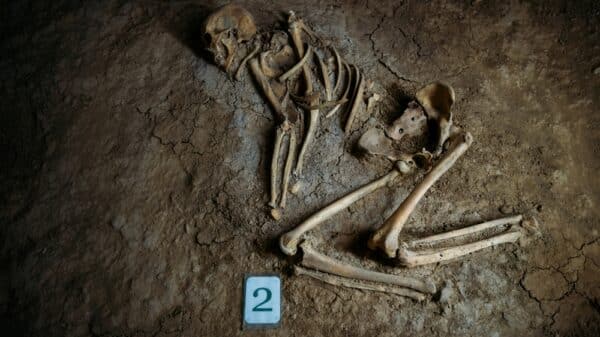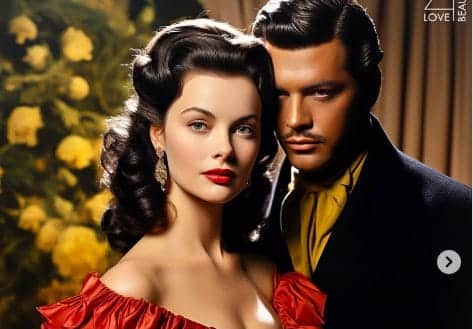The Familiar Sound
Sounds were often recycled in older films, including “Gone With the Wind.” For instance, the women’s screams in the Atlanta ballroom scene were later reused when Scarlett ventured onto Main Street in Atlanta. Initially used for excitement, the screams later conveyed fear.
Significant Milestones
“Gone With the Wind” marked numerous firsts in the movie industry. It was the inaugural film to receive over ten Oscar nominations and secure more than five Academy Awards. This achievement held particular weight since the Academy Awards date back to the late 1920s, setting the stage for record-breaking films in subsequent decades.
Unyielding Resilience
Despite facing obstacles like the Blitz and World War II, “Gone With the Wind” persisted in the United Kingdom for 216 weeks following its 1940 release. The film’s endurance amidst tumultuous historical events underscores its lasting appeal, drawing audiences for over four years.
Memorialized through Postage
In 1990, the United States Postal Service honored “Gone With the Wind” by issuing a special stamp featuring a heartfelt embrace between Clark Gable and Vivien Leigh. This commemorative stamp symbolized the enduring cultural impact of the film.
Accent Perfection
Recognizing the significance of authentic southern accents, the film’s producers engaged two accent coaches to ensure the actors delivered precise performances. Susan Myrick, a Southern dialect expert, played a pivotal role in guiding the actors on Southern speech and etiquette during screen tests.
Fitzgerald’s Unexplained Departure
Renowned author F. Scott Fitzgerald was briefly enlisted to assist with the script before being promptly dismissed. The circumstances surrounding his abrupt exit remain shrouded in mystery, given the confidentiality maintained by Fitzgerald and other production members.
Parental Decision Delays Casting
Adele Longmire, considered for the role of Scarlett, missed the chance to audition for the lead role due to her underage status and parental restrictions on traveling to New York for the audition. Her parents’ apprehensions regarding the contractual obligations associated with the role influenced their decision.
Preference for Southern Roots
Actress Paulette Goddard, a contender for Scarlett, was excluded from the role due to concerns linked to her New York origins and accent. David O. Selznick believed that American and southern audiences favored an English actress portraying the heroine over a New Yorker.
Close Call Casting
Vivien Leigh secured the role of Scarlett over Paulette Goddard after a rigorous audition process. Selznick’s unease regarding Goddard’s association with Charlie Chaplin and their unmarried cohabitation influenced the casting decision in favor of the lesser-known English actress Leigh.
Avoiding Publicity Pitfalls
Historically, Hollywood meticulously steered clear of scandals, such as refraining from casting Paulette Goddard as Scarlett due to her association with Charlie Chaplin. This cautious stance aimed to ward off negative publicity and safeguard the film’s reputation.
Strict adherence to specific guidelines dictated the inclusion of certain themes and language in films. The term “damn,” deemed unsuitable for use, led to Selznick incurring penalties for the film’s final scene. Although rumors swirled regarding a $5,000 fine for violating the Production Code, the speculation, irrespective of its accuracy, contributed to the movie’s publicity.
For additional evidence of the film’s profound impact, consider NBC’s astounding $5 million offer to MGM for television broadcast rights. Surprisingly, this substantial sum was paid for a single airing of the film, which eventually transpired in 1976.
The source material, “Gone with the Wind” novel, inspired numerous adaptations, with international iterations, including unexpected musical renditions. From a Japanese-British production titled “Scarlett” in the 1970s to a 1997 Japanese all-female musical and a 2003 French musical, the influence of the original novel extended globally. Further adaptations emerged in the UK and Canada in 2008 and 2013.
The ensemble of “Gone With the Wind” featured six Oscar-winning actors, including Vivien Leigh and Hattie McDaniel for their roles in the film, alongside Clark Gable, Olivia de Havilland, Thomas Mitchell, and Jane Darwell for other portrayals.
The quest for the ideal actress to embody Scarlett involved extensive auditions, occupying an entire day when viewed consecutively.
The initial script for the film extended to five and a half hours, resulting in a lengthy runtime despite efforts to trim it down. While the novel provided a vast source material, the script underwent further expansions, adding 15 pages to the already extensive narrative.
While the film garnered global acclaim, leading to unofficial “sequels” in various countries, an official film sequel never materialized. However, a GWTW TV sequel manifested as the 1994 miniseries “Scarlett,” based on the novel’s sequel.
As one of the most revered and beloved films, “Gone With the Wind” stands as one of the most quoted movies in history, with only 1942’s “Casablanca” surpassing it in terms of memorable lines. “Gone With the Wind” claimed the 1st, 31st, and 59th positions on the list of best movie quotes ever, showcasing iconic lines like “As God is my witness, I’ll never be hungry again!” and “After all, tomorrow is another day!””Frankly, my dear, I don’t give a damn.”
The epic narrative of “Gone With the Wind” revolves around four key characters, primarily appearing in separate scenes. Remarkably, there is only one scene throughout the entire movie featuring all four principal characters. Devoted enthusiasts can identify this scene. For those not yet fully immersed, the revelation occurs post the Shantytown assault when Rhett updates the others on the fate of Frank Kennedy, Scarlett’s second husband.
The story of the film unfolds across two distinct historical periods – the Civil War and the Reconstruction era. To emphasize the transition between these periods, the movie precisely splits in half at the shift to Reconstruction. However, this unique detail may not be consistent across all versions of the film, largely contingent on the editing choices for each iteration.
Despite its considerable length, meticulous attention to detail included subtle easter eggs accounting for every minute and second. Notably, during the Wilkes’ barbecue, Scarlett encounters all her future husbands within a span of just 90 seconds. Charles Hamilton, Frank Kennedy, and Rhett Butler are all briefly glimpsed in the entryway.
“Gone With the Wind” shattered numerous records, notably becoming the first color film to clinch an Oscar for Best Picture. Employing colors symbolically to represent Scarlett’s life stages, the film depicted her journey from innocence, dressed in white initially, to wearing black by the film’s conclusion, reflecting her evolution.the misery caused by her self-centered actions.
Dealing with weighty subjects, “Gone With the Wind” didn’t hinder fellow actors from enjoying themselves behind the scenes. Pulling pranks on each other was their idea of amusement. Clark Gable and Hattie McDaniel forged a close bond during filming, leading to some playful antics. In a memorable incident, Gable replaced Hattie’s tea with real alcohol, catching her off guard when she took a sip.
The film aimed to remain faithful to the book, but encountered a roadblock. Vivien Leigh’s eye color didn’t match Scarlett’s description in the book – Leigh had blue eyes while Scarlett had emerald green. Back in a time without CGI, manual post-production adjustments were necessary. Every frame had to be edited to turn Leigh’s eyes green. Colored contact lenses could have simplified this process significantly.
You might be aware that virtually every actress vied for the coveted role of Scarlett O’Hara. Even Katharine Hepburn, unrelated to the renowned Audrey, made an attempt but fell short. However, she landed a different prominent role as the maid of Honor at Vivien Leigh and Laurence Olivier’s wedding.
In the world of acting, it’s not always about the size of the role but often about the star power. Hence, the initial film posters listed Clark Gable’s name first and Vivien Leigh’s at the end. Subsequently, the posters were revised after Vivien clinched an Oscar for the role of Scarlett.
It may sound blunt, but Leslie Howard’s absence at the premiere had a valid reason. The English actor returned to England due to WW2, as he was enlisted in British intelligence. Despite his wartime commitments, he continued acting, starring in three films during the war.
Unbelievably, it was actually Martin Luther King Sr., not Jr., who was invited to the Atlanta Premiere. As a famous Atlanta preacher, he was initially advised against attending due to the film’s exclusion of a black actor. Nevertheless, he attended along with his son, Martin Luther King Jr.
Today’s actors are expected to have diverse talents, yet Vivien Leigh, the star of “Gone With the Wind”, couldn’t dance and had a dance double for the film. There were occasions when she refused to simulate vomiting sounds, requiring another actress to fill in. Director George Cukor prompted Leigh to slap her co-star, resulting in genuine tears and reconciliation between the two actresses. Hattie McDaniel remained in character while meeting producers, and Olivia de Havilland researched childbirth for her role. Thomas Mitchell’s horse had prior film appearances, and Leigh and Clark Gable were known for heavy smoking during filming. Leigh also clashed with directors creatively, and McDaniel faced backlash for portraying a black woman as a maid.
Community backlash didn’t deter Hattie McDaniel from taking on the challenging role. Viewing it as a lucrative opportunity, she famously quipped that she preferred earning “seven hundred dollars a week playing a maid than seven dollars actually being one.”
Olivia de Havilland Had a Mischievous Streak
Contrary to her on-screen persona, Olivia de Havilland delighted in playing pranks and practical jokes on her co-stars. One such prank almost led to Clark Gable straining his back during a scene where he had to carry her, as she had anchored herself to the set.
Private Sessions
Although director George Cukor was rarely on set, actresses Olivia de Havilland and Vivien Leigh felt they could benefit from private coaching with him. Interestingly, this was kept secret from the other directors involved in the film.
A Lengthy Affair
The initial cut of the four-hour epic was 48 minutes longer than the final version, reflecting the challenge of editing 88 hours of raw footage down to a four-hour runtime.
Farewell
The film’s nearly four-hour duration prominently featured its lead character, Scarlett, enacted by Vivien Leigh, who graced the screen for roughly 2.5 hours. This portrayal holds the record for the longest duration for which a single actor has won an Oscar.
Unforgettable Soundtrack
The original score for “Gone With the Wind,” spanning almost three hours, was composer Max Steiner’s lengthiest piece at that time. Crafting the music involved the collaboration of five orchestrators and showcased two primary themes.
Scoring Achievement
Max Steiner completed the film’s score in just three months, an impressive feat given he also composed scores for twelve other films that same year. To keep up with the demanding workload, he occasionally turned to chemicals to stay awake for up to 20 hours.
Role Reservations
A number of actors in the film expressed dissatisfaction with their characters. Notably, Clark Gable initially hesitated to play Rhett Butler and only agreed under the condition of studio assistance with personal matters. Leslie Howard and Rand Brooks also harbored grievances about their respective roles.
Author’s Input
Producer David O. Selznick sought author Margaret Mitchell’s opinion on various aspects of the film, including Vivien Leigh’s portrayal of Scarlett O’Hara.
One notable critique from Margaret Mitchell regarding the Tara mansion design was overlooked, leading to Mitchell refraining from further comments on the production.
Ageless Artistry
At the time of filming, Barbara O’Neil, who played Ellen O’Hara, Scarlett’s mother, was 28 years old portraying the mother of a 16-year-old character. Vivien Leigh, aged 25, portrayed Scarlett alongside a mother only three years her senior. Thomas Mitchell, portraying Scarlett’s father, was 47.
Enduring Legacy
Olivia de Havilland, the eldest surviving cast member, attended the 70th and 80th anniversaries of the film before passing away in 2020 at the impressive age of 104.
Selecting Rhett
Despite considering other actors like Ronald Colman, Errol Flynn, and Gary Cooper, Clark Gable was ultimately chosen to portray Rhett Butler. Cooper hesitated, questioning the film’s potential success.
Choice of Words
Margaret Mitchell had several title ideas for her novel, such as “Ba! Ba! Black Sheep,” “Tomorrow Is Another Day,” “Tote the Weary Load,” “Not in Our Stars,” or “Bugles Sang True.” Initially, Scarlett’s name in the novel was Pansy.
Devoted Collector
James Tumblin, an avid “Gone With the Wind” fan, amassed over 300,000 memorabilia items, some of which were featured in a 2012 exhibition.
Styled Elegantly
Scarlett O’Hara’s attire became highly sought after by collectors and enthusiasts. A dress she wore, purchased for $20, was later auctioned for $137,000. A straw hat she sported fetched $52,500.
Horses in the Spotlight
Approximately 1,100 horses and mules were used in street scenes. Some horses had distinct roles, like Thomas Mitchell’s white horse named Silver Chief and Cammie King’s black horse named Mister Butler.
The Making of the Screenplay
Creating the screenplay was a painstaking process, involving countless hours of crafting.The novel’s entire conversation could have been transformed into a 168-hour-long film. The approved lines were filmed on 500,000 feet of film.
Setting New Records
“Gone With the Wind” clinched eight Academy Awards out of thirteen nominations, establishing an unmatched record in modern cinema.
The Giant of All Blockbusters
“Gone With the Wind” established a milestone by being the lengthiest sound film to win an Oscar for Best Picture, clocking in at 234 minutes. Additionally, its colossal impact at the box office tallied around 4 billion dollars when adjusted for inflation. This accomplishment even secured a position in the Guinness World Records as the most profitable film in history.
Ensuring Affordability
Upon its 1936 release, “Gone With the Wind” sparked a global craze and saw millions of sales. Despite the immense triumph of the book, the film rights were initially fetched for only $50,000. Nonetheless, producer David O. Selznick later comprehended their genuine value and granted the author, Margaret Mitchell, a $50,000 bonus.
Bringing Baby Wilkes to Life
The unforgettable character of Melanie Hamilton, depicted by Olivia de Havilland, is renowned for the moment when she delivers a baby. To ensure an authentic portrayal, the director physically pinched the actress’s toes off-camera to solicit a demonstration of anguish.
Just an Informal Chart-Topper
Margaret Mitchell penned “Gone With the Wind” as a pastime while recuperating from a car accident. The book unexpectedly soared in popularity, becoming the second most sought-after book in the United States, trailing only the Bible.
Say Farewell to Alfred Hitchcock
Producer David O. Selznick sought Alfred Hitchcock’s assistance in converting the book into a script. However, Selznick disregarded all of Hitchcock’s detailed recommendations and instead engaged with sixteen writers over several months for the conversion.
The Covert Screening
The initial viewing of the film was shrouded in secrecy, with the audience uninformed about the feature they were about to witness. The confidentiality extended to securing the cinema doors during the screening to prevent any accidental leaks of spoilers.
Where’s the Oscar Hidden?
Post Michael Jackson’s demise, it was unearthed that he held producer David O. Selznick’s Oscar. Despite endeavors to locate it, the trophy remained elusive, sparking speculation about its location.
Michael Was an Admirer
Michael Jackson, a well-known enthusiast of “Gone With the Wind,” acquired the Best Picture Oscar statuette previously owned by David O. Selznick for $1,542,500, showcasing his admiration for the film.
A Tangible National Holiday
In England, “Gone With the Wind” garnered such immense popularity that a national day off was observed at its premiere. The film’s triumph transcended the screen, evolving into a cultural marvel.
off in remembrance of Kate and William’s union. It appears that “Gone With the Wind” had a similar resonance. The film premiered in December of 1939 to high anticipation, notably in Atlanta, where the regional government marked it as a special day!
Jimmy Carter, in his pre-presidential era, reflects on it as the most pivotal occurrence in the South during his lifespan.
A Grand Opening
The premiere of the movie in 1939 was a grand affair. With intense anticipation preceding its launch, approximately 300,000 individuals crowded the streets around the Atlanta premiere venue. The limos transporting the stars paraded in a lengthy procession, with the event featuring an extravagant costume ball.
It’s All About the Bucks
In today’s era, the wage disparity is a prevalent concern that many are endeavoring to rectify. However, during the film’s creation, the scenario was starkly different. There existed a significant pay gap between the two main leads: Clark Gable, with 70 days of filming, pocketed $120,000, while Vivien Leigh, with 125 filming days, received a mere $25,000.
Leslie Howard’s Dilemma
Leslie Howard, essaying Ashley Wilkes, the character who eventually marries Melanie Hamilton, harbored reservations about his role. He felt he wasn’t the ideal fit, mainly because he was 40 at the time, whereas the character’s age he portrayed was 21. Despite his acclaimed performance, he harbored a distaste for the role owing to feelings of inadequacy.
Film Math
The filming technology in 1930s Hollywood was limited, posing a challenge for shooting one of the initial scenes. The scene of Scarlett watching the sunset with her father against the family estate backdrop was rendered feasible with the aid of UCLA mathematicians. Producer David Selznick solicited their help, and they utilized numbers and formulas to craft a lifelike backdrop for the actors to be filmed against.
On-Set Camaraderie
Hattie McDaniel and Clark Gable nurtured a friendship while collaborating on set. Regrettably, their amiable bond remained clandestine due to the societal and political ambiance of 1930s Hollywood. Strangely, it was unlawful for McDaniel to even attend the film premiere. Gable was incensed by this and almost boycotted the event in protest but was persuaded otherwise by Hattie herself.
Parting with Partners
At the outset of the film’s production, Clark Gable was wedded to Texan socialite Maria Langham while secretly engaging with actress Carole Lombard. With the studio’s backing, Gable divorced Langham and wedded Lombard clandestinely. In a parallel fashion, Vivien Leigh was romantically entangled with Laurence Olivier while being married to Herbert Leigh Holman. She ultimately tied the knot with Olivier post her divorce from Herbert.
Got a Screen Actors Guild Card? You’re Enlisted
Amidst the nearly 4-hour cinematic feat of “Gone With the Wind,” myriad issues, including the terrors of war, were explored. The scene following the battle, revealing the anguish of wounded soldiers, was intended to be filmed with 2,500 extras, yet the Screen Actors Guild boasted only roughly 1,500 registered extras. To fill the remaining slots, top-notch mannequins were employed.
Embarking with Destruction
The inaugural scene filmed for the movie depicted Atlanta ablaze. The fire was fueled by ancient set components from prior productions. The intense blaze yielded nearly 2 hours of footage and triggered numerous reports to the fire department from individuals convinced the studio was on fire. Capturing this inferno had to be executed in a single take as there was no time or means for a redo.“`html
Affection Unveiled
Clark Gable embodied Rhett Butler and was a desired figure for many. Vivien Leigh, who shared a kiss with him in the film, found the experience lackluster as Gable sported malodorous dentures and played a garlic prank before their famous kiss scene.
Frankly, My Dear, I Couldn’t Care Less?
The movie “Gone With the Wind” confronted hurdles with the inclusion of the word “damn” and wrestled with negotiating its acceptance with the Motion Picture Association for several months.
Pioneering Feat by Hattie McDaniel
Hattie McDaniel etched her name in history as the first black woman to claim an Academy Award for her portrayal as Mammy in the film. Nevertheless, due to discriminatory laws prevailing at the time, she was barred from attending the premiere.
Tears Welling in Tough Guys
Clark Gable declined to shed tears in his depiction of Rhett Butler and even contemplated exiting when instructed to tear up on camera. Eventually, he delivered a poignant crying scene after learning of Scarlett’s staircase mishap.
Clash of Personalities with Clark
Speculations emerged that director George Cukor was ousted due to Clark Gable’s discontent with him, perceiving Cukor to be dedicating excessive attention to Vivien Leigh and not enough to him.
In Pursuit of Scarlett
Selecting the ideal actress to embody Scarlett O’Hara demanded thorough scrutiny, with numerous budding actresses contending for the role. The initial shoot even commenced with a body-double standing in until Vivien Leigh was cast, despite initial hesitations regarding an English actress tackling the role.
Directors Meeting Abrupt Endings
“Gone With the Wind” witnessed three different directors during its crafting, including George Cukor, who was dismissed after 18 days, and Victor Flemming, who experienced a mental breakdown midway through filming and was transiently substituted by Sam Wood.
Image Source: love4beautyart @ Instagram



































